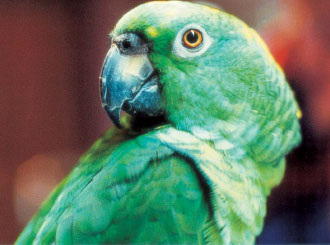Project 49: Parrot
This Yellow-Naped Amazon was part of a group of exotic animals shown at the World Wildlife Exposition in Gatlinburg, Tennessee, where I was also exhibiting my wildlife art. I was impressed by this parrot’s intelligent eyes, as well as its beautiful feathers.


Reference Photo
Materials
Paints
Burnt Umber
Cadmium Orange
Hansa Yellow Light
Hooker’s Green Permanent
Raw Sienna
Red Oxide
Titanium White
Ultramarine Blue
Brushes
no. 3 and 10 rounds
no. 8 and 10 brights

1 Establish the Form
Lightly sketch the parrot onto your panel in pencil, using a kneaded eraser to lighten lines or correct mistakes. With a no. 10 round and diluted Burnt Umber, paint the basic lines and shading of the parrot.

2 Paint the Dark Values and Background
Mix warm black for the darkest parts of the parrot with Burnt Umber and Ultramarine Blue. Paint with a no. 10 round, switching to a no. 3 round for the dark ring around the eye.
Make a cool red background color with Red Oxide, Burnt Umber and Ultramarine Blue. Then create a lighter red background color using the same colors plus Raw Sienna, Cadmium Orange and Titanium White. Paint with separate no. 10 brights, starting with the darker color at the lower part of the painting. Blend up into the lighter red with dabbing strokes.

3 Finish the Background and Paint the Middle Values
Mix a green feather color with Hooker’s Green Permanent, Cadmium Orange, Titanium White and Hansa Yellow Light. Paint with a no. 8 bright, using strokes that follow the feather pattern. Re-establish the main shadow lines in the feathers with warm black and a no. 10 round.
Mix gray with Titanium White, Burnt Umber and Ultramarine Blue. Paint the beak and the cere (the membrane at the base of the beak) with a no. 10 round. Mix blue for the ring around the eye with Titanium White, Ultramarine Blue and a small amount of Burnt Umber. Paint with a no. 10 round. Mix dark orange for the eye with Red Oxide, Cadmium Orange and a bit of Burnt Umber. Use a no. 3 round to paint around the outer edge of the eye.

A WISE AND INTELLIGENET BIRD
Acrylic on Gessobord
8” × 10” (20cm × 25cm)
4 Paint the Light Values and the Finishing Details
Make light green for the feather highlights with a portion of the green feather color, Titanium White and Hansa Yellow Light. With a no. 10 round, paint the highlighted area at the top of the head and along the back.
Create warm white with Titanium White and a touch of Hansa Yellow Light. Paint highlights on the back with a no. 10 round, using separate no. 10 rounds for gray and warm black to blend. Use no. 3 rounds for the finer details. Paint the cere with the same colors, using small, dabbing strokes to show texture.
Make a yellow for the ring of color around the eye next to the pupil with Titanium White, Hansa Yellow Light and a touch of Cadmium Orange. Paint with a no. 3 round, blending with dark orange and a separate no. 3 round. Re-establish the dark outer ring around the eye with warm black and a no. 3 round.
Mix Hansa Yellow Light and a bit of Titanium White to create bright yellow for the scattered yellow feathers on the head. Paint with a no. 10 round.
With warm black and a no. 10 round, begin to paint the shadows that define the edges of the feathers with light, parallel strokes. Blend with a separate brush and the green feather color, using small strokes. Paint the highlighted area at the top of the head in the same way, using the green feather color for the shadows, blending with small strokes of light green.
With no. 3 rounds, use warm black to lightly paint detail in the blue area around the eye, blending with blue. Paint a highlight in the eye with Titanium White and a no. 3 round, blending the edges with warm black and a separate brush.
Continue to paint the feather shadow detail with warm black. Paint feather highlights with light green, blending with the green feather color.
